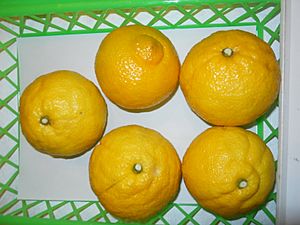Haruka (citrus) facts for kids
Quick facts for kids Haruka |
|
|---|---|

Haruka citrus fruits
|
|
| Genus | Citrus |
| Species | Citrus tamurana |
| Hybrid parentage | Hyuganatsu x natsudaidai |
| Cultivar | Haruka |
| Origin | Ehime Prefecture, Japan |
Haruka (Citrus tamurana x natsudaidai) is a special type of citrus fruit. It is grown mainly in Japan and also in the Korean Peninsula. It's known for its sweet taste and unique features.
Contents
Haruka's Family Tree
The Haruka fruit was first found in Ehime Prefecture, Japan. At first, people thought it was a natural change of the hyuganatsu fruit. But now, scientists believe it's a mix of two different citrus fruits.
Haruka is a hybrid fruit. This means it was created by crossing two parent plants. Its parents are the hyuganatsu and the natsudaidai fruits. The hyuganatsu was the "seed parent," which means it provided the seed. The natsudaidai was the "pollen parent," which means it provided the pollen.
What Does Haruka Look Like?
Haruka fruits are usually small to medium in size. They are about the same size as an orange. They can be round, flat, or pear-shaped.
The skin of the Haruka fruit is yellow and quite thick. It feels smooth but has small pores. The skin also smells very nice. Inside, the fruit has bright yellow flesh. It is divided into 10 to 11 sections by thin membranes. Haruka fruits usually have some seeds.
You might notice a small bump on the bottom of the fruit. Sometimes, there's also a tiny bump where the stem was attached.
Haruka's Taste and How to Eat It
The Haruka fruit tastes very sweet, but its flavor is quite mild. One special thing about Haruka, like its parent fruit hyuganatsu, is its white, spongy inner layer called the pith. This pith is sweet and you can eat it!
Most people eat Haruka fruit fresh and raw. They usually eat it with the sweet pith still on. Haruka fruits ripen from late winter to spring. Once picked, they can stay fresh for 1 to 3 weeks if you keep them in a refrigerator.
Healthy Haruka!
Haruka fruit is good for you! It has a lot of vitamin A and vitamin C. It also contains smaller amounts of vitamin B1 and beta-carotene. These vitamins help your body stay healthy and strong.
Where Haruka Grows and Goes
Haruka is grown in southern Japan. The main places where it grows are Ehime and Hiroshima prefectures.
You can buy Haruka fruits in markets across Japan. They are also sent to other countries. You might find them in Singapore, Taiwan, and Hong Kong.
Haruka in Sweets
Did you know that Haruka citrus fruit has inspired a candy flavor? A type of Japanese candy called Puccho has a flavor based on the delicious Haruka fruit.

